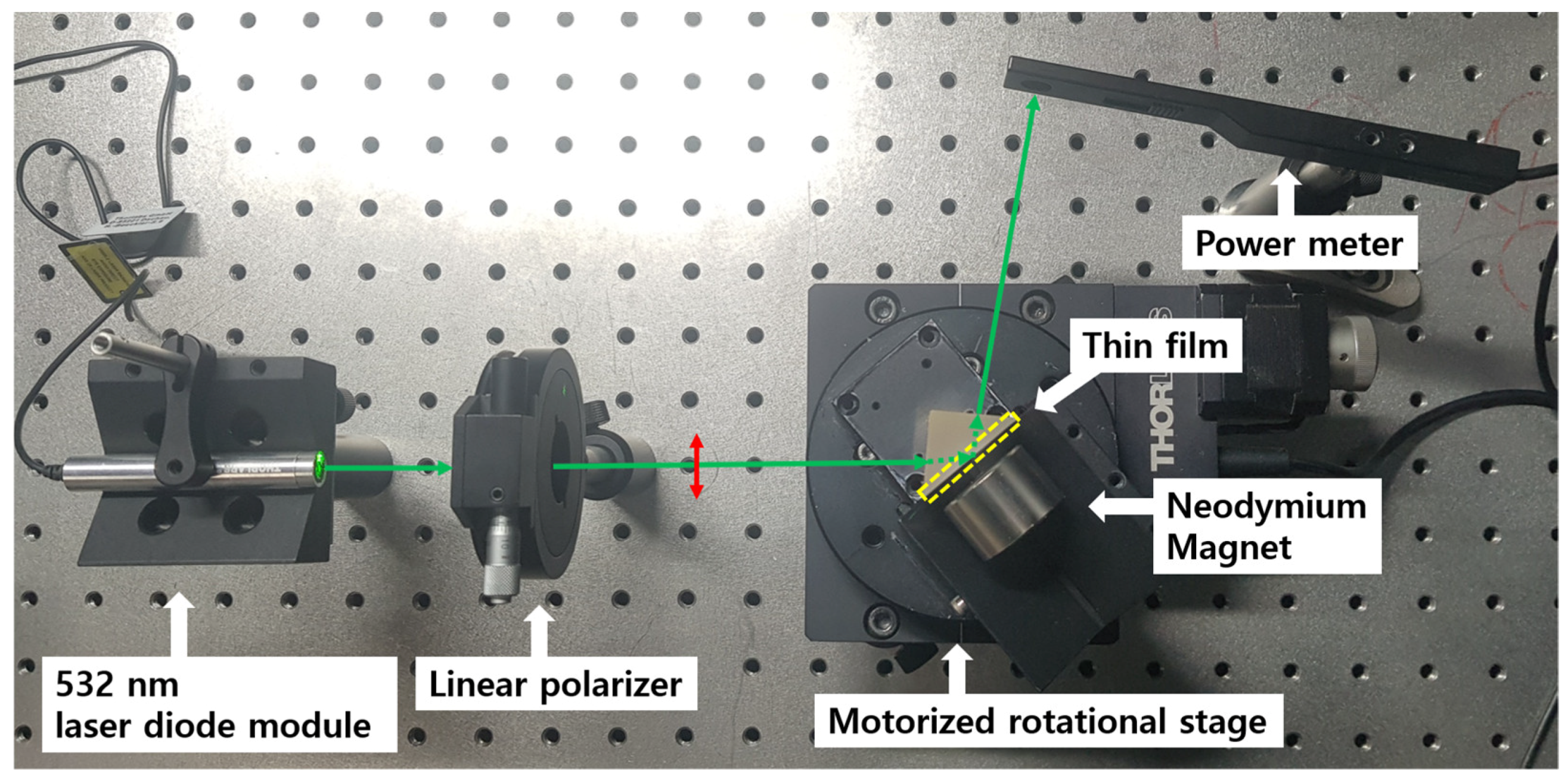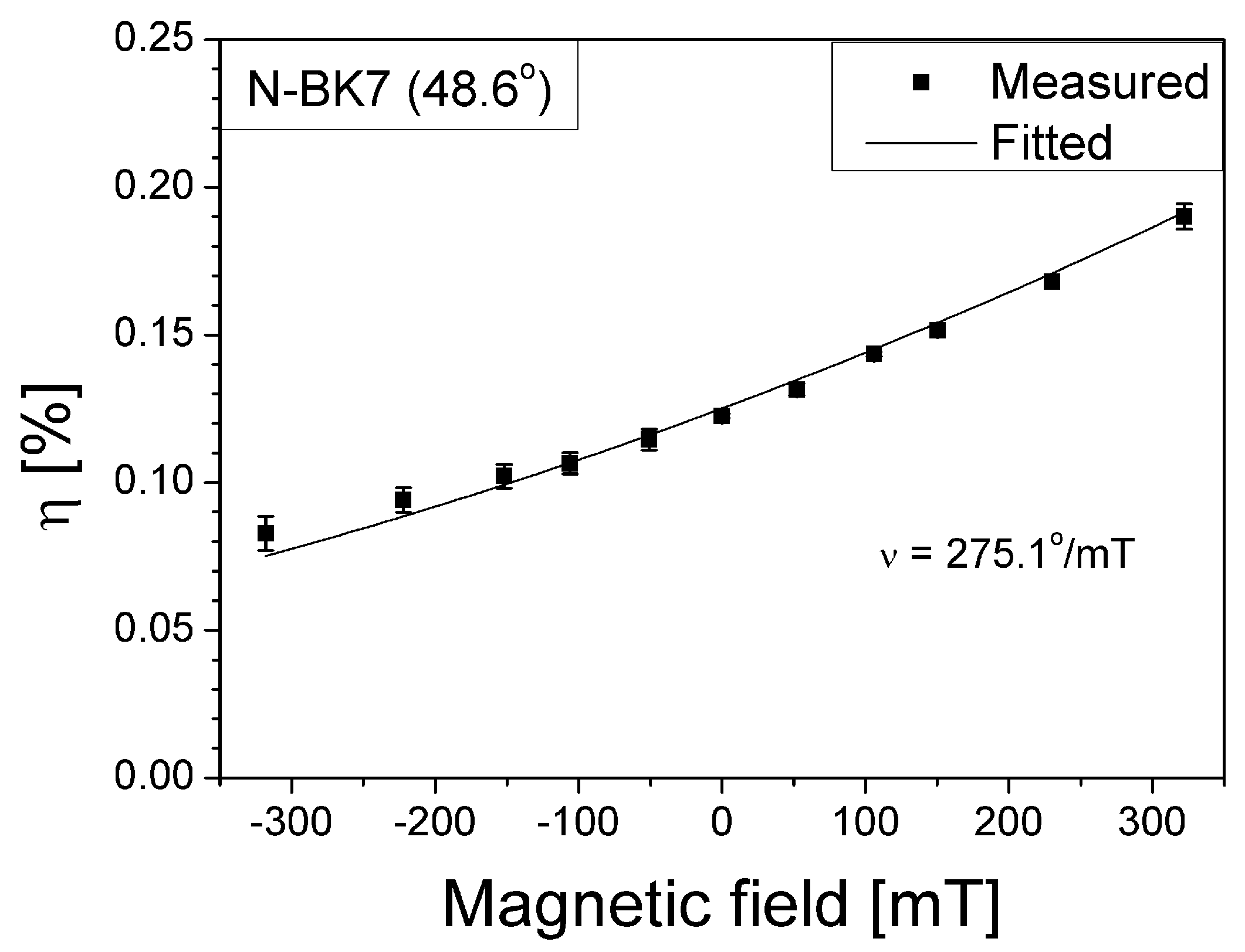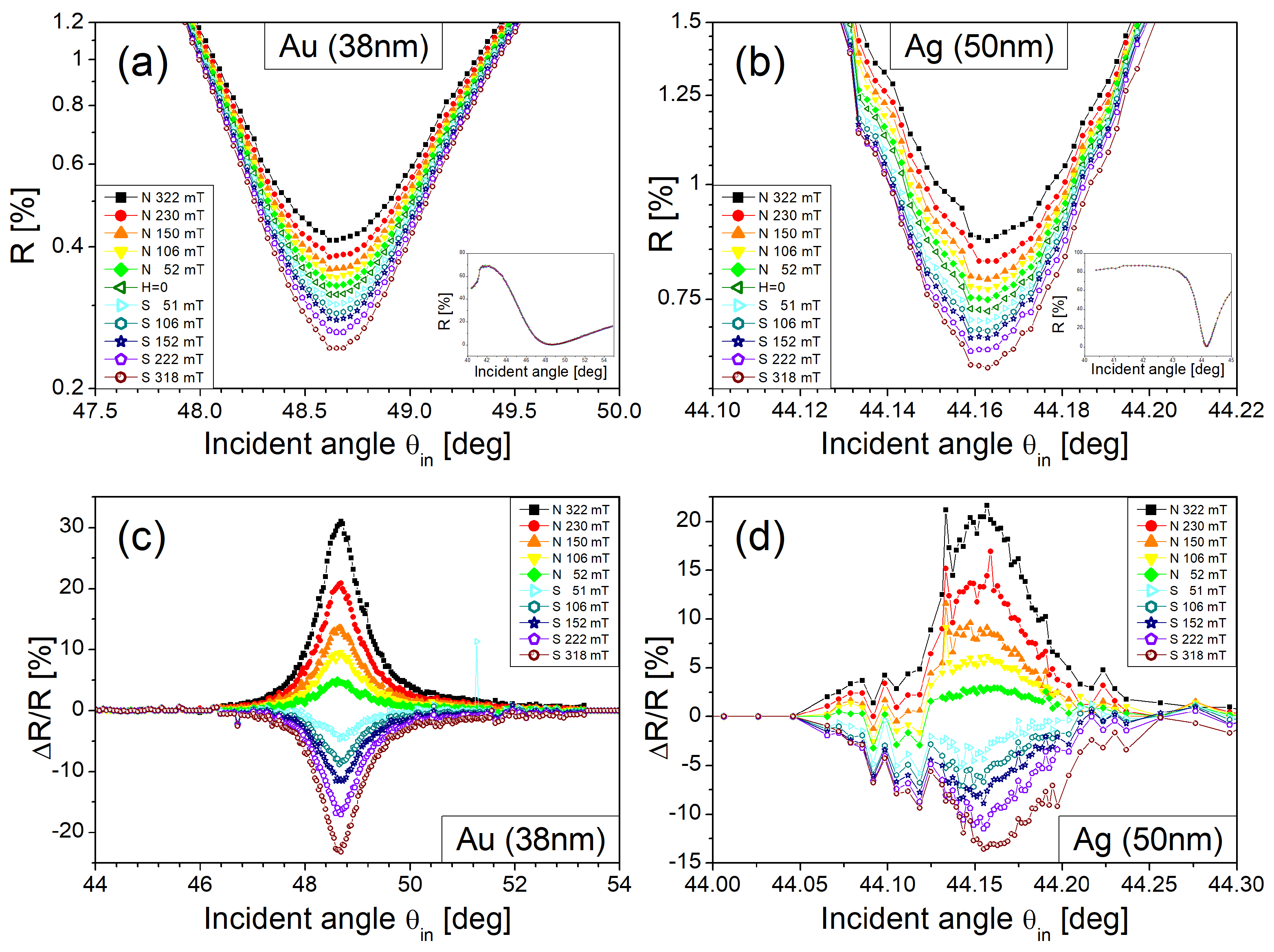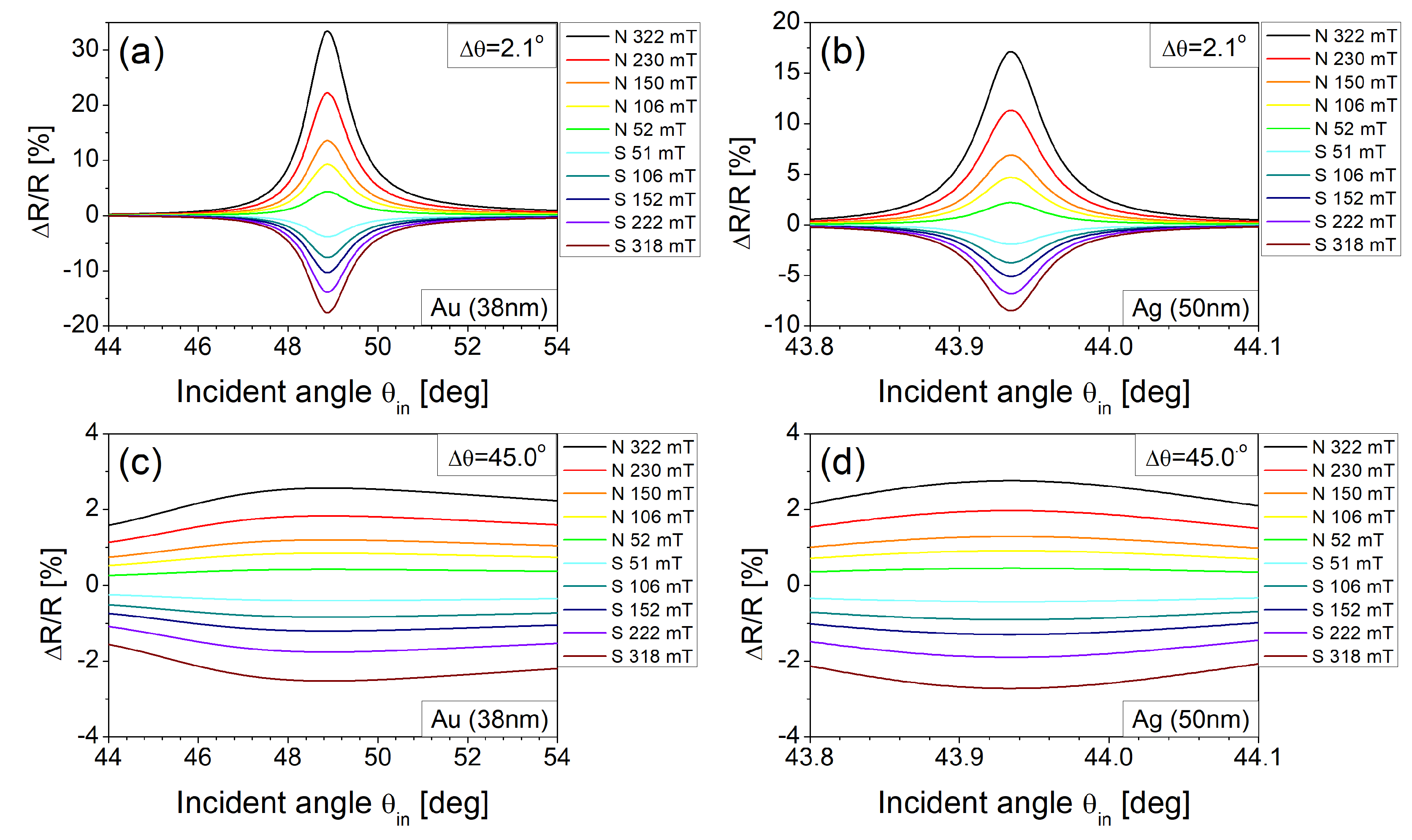Magnetic Control of Optical Reflectance from Metallic Thin Film Using Surface Plasmon Resonance and Faraday Rotation
Abstract
1. Introduction
2. Experimentals
3. Results and Discussion
4. Conclusions
Author Contributions
Funding
Institutional Review Board Statement
Informed Consent Statement
Data Availability Statement
Conflicts of Interest
References
- Crassee, I.; Levallois, J.; Walter, A.L.; Ostler, M.; Bostwick, A.; Rotenberg, E.; Seyller, T.; van der Marel, D.; Kuzmenko, A.B. Giant Faraday rotation in single-and multilayer graphene. Nat. Phys. 2011, 7, 48–51. [Google Scholar] [CrossRef]
- Labeyrie, G.; Miniatura, C.; Kaiser, R. Large Faraday rotation of resonant light in a cold atomic cloud. Phys. Rev. A 2001, 64, 033402. [Google Scholar] [CrossRef]
- Mansuripur, M. The faraday effect. Opt. Photonics News 1999, 10, 32–36. [Google Scholar] [CrossRef]
- Uchida, H.; Masuda, Y.; Fujikawa, R.; Baryshev, A.; Inoue, M. Large enhancement of Faraday rotation by localized surface plasmon resonance in Au nanoparticles embedded in Bi:YIG film. J. Magn. Magn. Mater. 2009, 321, 843–845. [Google Scholar] [CrossRef]
- Hamidi, S.M.; Tehranchi, M.M. Magneto-optical Faraday rotation in Ce: YIG thin films incorporating gold nanoparticles. J. Supercond. Nov. Magn. 2011, 25, 2713–2717. [Google Scholar] [CrossRef]
- Sadatgol, M.; Rahman, M.; Forati, E.; Levy, M.; Güney, D.Ö. Enhanced Faraday rotation in hybrid magne-to-optical metamaterial structure of bismuth-substituted-iron-garnet with embedded-gold-wires. J. Appl. Phys. 2016, 119, 103105. [Google Scholar] [CrossRef]
- Yang, Z.J.; Scheinfein, M.R. Combined three-axis surface magneto-optical Kerr effects in the study of sur-face and ultrathin-film magnetism. J. Appl. Phys. 1993, 74, 6810–6823. [Google Scholar] [CrossRef]
- You, C.-Y.; Shin, S.-C. Generalized analytic formulae for magneto-optical Kerr effects. J. Appl. Phys. 1998, 84, 541–546. [Google Scholar] [CrossRef]
- Qiu, Z.Q.; Bader, S.D. Surface magneto-optic Kerr effect. Rev. Sci. Instrum. 2000, 71, 1243–1255. [Google Scholar] [CrossRef]
- Paliwal, A.; Tomar, M.; Gupta, V. Study of optical properties of Ce and Mn doped BiFeO3 thin films using SPR technique for magnetic field sensing. Vacuum 2018, 158, 48–51. [Google Scholar] [CrossRef]
- Aplet, L.J.; Carson, J.W.; Aplet, L.J.; Carson, J.W. A Faraday effect optical isolator. Appl. Opt. 1964, 3, 544–545. [Google Scholar] [CrossRef]
- Sun, L.; Jiang, S.; Zuegel, J.D.; Marciante, J.R. All-fiber optical isolator based on Faraday rotation in highly terbium-doped fiber. Opt. Lett. 2010, 35, 706–708. [Google Scholar] [CrossRef]
- Jacobs, S.D.; Teegarden, K.J.; Ahrenkiel, R.K. Faraday rotation optical isolator for 10.6-μm radiation. Appl. Opt. 1974, 13, 2313–2316. [Google Scholar] [CrossRef]
- Chin, J.Y.; Steinle, T.; Wehlus, T.; Dregely, D.; Weiss, T.; Belotelov, V.I.; Stritzker, B.; Giessen, H. Nonreciprocal plasmonics enables giant enhancement of thin-film Faraday rotation. Nat. Commun. 2013, 4, 1599. [Google Scholar] [CrossRef] [PubMed]
- Raether, H. Surface plasmons on smooth surfaces. In Surface Plasmons on Smooth and Rough Surfaces and on Gratings; Springer: Berlin/Heidelberg, Germany, 1988; pp. 4–39. [Google Scholar]
- Kim, J.; Son, C.; Choi, S.; Yoon, W.J.; Ju, H. A plasmonic fiber based glucometer and its temperature dependence. Micromachines 2018, 9, 506. [Google Scholar] [CrossRef] [PubMed]
- Raj, D.R.; Prasanth, S.; Vineeshkumar, T.; Sudarsanakumar, C. Surface Plasmon Resonance based fiber optic sensor for mercury detection using gold nanoparticles PVA hybrid. Opt. Commun. 2016, 367, 102–107. [Google Scholar] [CrossRef]
- Alberto, N.; Domingues, M.F.; Marques, C.; André, P.; Antunes, P. Optical fiber magnetic field sensors based on magnetic fluid: A review. Sensors 2018, 18, 4325. [Google Scholar] [CrossRef]
- Liu, Q.; Li, S.; Li, H.; Zi, J.; Zhang, W.; Fan, Z.; An, G.; Bao, Y. Broadband single-polarization photonic crystal fiber based on surface plasmon resonance for polarization filter. Plasmonics 2015, 10, 931–939. [Google Scholar] [CrossRef]
- Kabashin, A.V.; Kochergin, V.E.; Nikitin, P.I. Surface plasmon resonance bio- and chemical sensors with phase-polarisation contrast. Sens. Actuators B Chem. 1999, 54, 51–56. [Google Scholar] [CrossRef]
- Zhang, N.M.Y.; Hu, D.J.J.; Shum, P.P.; Wu, Z.; Li, K.; Huang, T.; Wei, L. Design and analysis of surface plasmon resonance sensor based on high-birefringent microstructured optical fiber. J. Opt. 2016, 18, 065005. [Google Scholar] [CrossRef]
- Ferreiro-Vila, E.; González-Díaz, J.B.; Fermento, R.; González, M.U.; García-Martín, A.; Garcia-Martin, J.M.; Cebollada, A.; Armelles, G.; Meneses-Rodríguez, D.; Sandoval, E.M. Intertwined magneto-optical and plasmonic effects in Ag/Co/Ag layered structures. Phys. Rev. B 2009, 80, 125132. [Google Scholar] [CrossRef]
- Martín-Becerra, D.; González-Díaz, J.B.; Temnov, V.V.; Cebollada, A.; Armelles, G.; Thomay, T.; Leitenstorfer, A.; Bratschitsch, R.; García-Martín, A.; González, M.U. Enhancement of the magnetic modulation of surface plasmon polaritons in Au/Co/Au films. Appl. Phys. Lett. 2010, 97, 183114. [Google Scholar] [CrossRef]
- Herreño-Fierro, C.A.; Patiño, E.J. Maximization of surface-enhanced transversal magneto-optic Kerr effect in Au/Co/Au thin films. Phys. Status Solidi (b) 2015, 252, 316–322. [Google Scholar] [CrossRef][Green Version]
- Jain, A.; Kumar, J.; Zhou, F.; Li, L.; Tripathy, S. A simple experiment for determining Verdet constants using alternating current magnetic fields. Am. J. Phys. 1999, 67, 714–717. [Google Scholar] [CrossRef]
- Peyghambarian, N.; Norwood, R.A.; Persoons, A. In-Fiber Magneto-Optic Devices Based on Ultrahigh Verdet Constant Organic Materials and Holey Fibers; Arizona Univ Board of Regents Tucson: Tucson, AZ, USA, 2009; Available online: https://apps.dtic.mil/sti/citations/ADA495425 (accessed on 2 February 2009).
- Sepúlveda, B.; González-Díaz, J.B.; García-Martín, A.; Lechuga, L.M.; Armelles, G. Plasmon-induced magneto-optical activity in nanosized gold disks. Phys. Rev. Lett. 2010, 104, 147401. [Google Scholar] [CrossRef] [PubMed]
- Newman, D.M.; Wears, M.L.; Matelon, R.J.; Hooper, I.R. Magneto-optic behaviour in the presence of surface plasmons. J. Phys. Condens. Matter 2008, 20, 345230. [Google Scholar] [CrossRef]
- Hermann, C.; Kosobukin, V.A.; Lampel, G.; Peretti, J.; Safarov, V.I.; Bertrand, P. Surface-enhanced mag-neto-optics in metallic multilayer films. Phys. Rev. B 2001, 64, 235422. [Google Scholar] [CrossRef]




Publisher’s Note: MDPI stays neutral with regard to jurisdictional claims in published maps and institutional affiliations. |
© 2021 by the authors. Licensee MDPI, Basel, Switzerland. This article is an open access article distributed under the terms and conditions of the Creative Commons Attribution (CC BY) license (https://creativecommons.org/licenses/by/4.0/).
Share and Cite
Son, C.; Ju, H. Magnetic Control of Optical Reflectance from Metallic Thin Film Using Surface Plasmon Resonance and Faraday Rotation. Materials 2021, 14, 3354. https://doi.org/10.3390/ma14123354
Son C, Ju H. Magnetic Control of Optical Reflectance from Metallic Thin Film Using Surface Plasmon Resonance and Faraday Rotation. Materials. 2021; 14(12):3354. https://doi.org/10.3390/ma14123354
Chicago/Turabian StyleSon, Changjin, and Heongkyu Ju. 2021. "Magnetic Control of Optical Reflectance from Metallic Thin Film Using Surface Plasmon Resonance and Faraday Rotation" Materials 14, no. 12: 3354. https://doi.org/10.3390/ma14123354
APA StyleSon, C., & Ju, H. (2021). Magnetic Control of Optical Reflectance from Metallic Thin Film Using Surface Plasmon Resonance and Faraday Rotation. Materials, 14(12), 3354. https://doi.org/10.3390/ma14123354





